The Glass Mat Thermoplastic Market is estimated to be valued at USD 1.6 billion in 2025 and is projected to reach USD 4.1 billion by 2035, registering a compound annual growth rate (CAGR) of 9.5% over the forecast period.
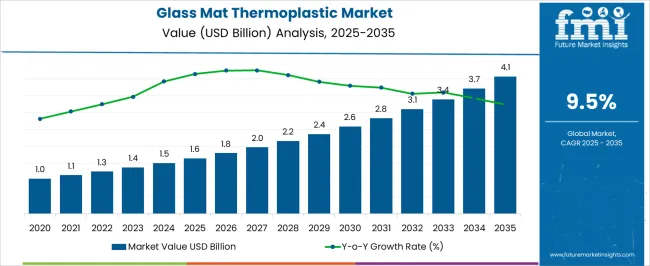
| Metric | Value |
|---|---|
| Glass Mat Thermoplastic Market Estimated Value in (2025 E) | USD 1.6 billion |
| Glass Mat Thermoplastic Market Forecast Value in (2035 F) | USD 4.1 billion |
| Forecast CAGR (2025 to 2035) | 9.5% |
The Glass Mat Thermoplastic (GMT) market is experiencing steady growth, driven by increasing demand for lightweight, durable, and high-performance composite materials across automotive, transportation, and industrial sectors. Rising focus on vehicle weight reduction to improve fuel efficiency and meet stringent emission standards is contributing to the expanding adoption of GMT materials. Advancements in processing technologies and thermoplastic formulations have enhanced mechanical properties, impact resistance, and thermal stability, enabling broader industrial applications.
The market is further supported by ongoing research and development in high-performance composites, which improve manufacturability and cost-effectiveness. Environmental considerations, such as recyclability and sustainability, are also driving preference for GMT solutions over conventional metals.
Integration of GMT into mass-produced automotive components, industrial equipment, and consumer goods is enabling operational efficiency and design flexibility As manufacturers increasingly prioritize lightweight materials for enhanced performance and compliance with global regulations, the Glass Mat Thermoplastic market is expected to witness sustained expansion, supported by innovations in raw material development, composite processing, and end-use applications.
The glass mat thermoplastic market is segmented by raw material, type of product, application, and geographic regions. By raw material, glass mat thermoplastic market is divided into Polypropylene (PP), Polyamide (PA), and Thermoplastic Polyester (TPP). In terms of type of product, glass mat thermoplastic market is classified into Traditional GMT and Advanced GMT. Based on application, glass mat thermoplastic market is segmented into Automobile And Transportation, Aerospace & Defense, Electrical & Electronics, Consumer Goods, and Others. Regionally, the glass mat thermoplastic industry is classified into North America, Latin America, Western Europe, Eastern Europe, Balkan & Baltic Countries, Russia & Belarus, Central Asia, East Asia, South Asia & Pacific, and the Middle East & Africa.
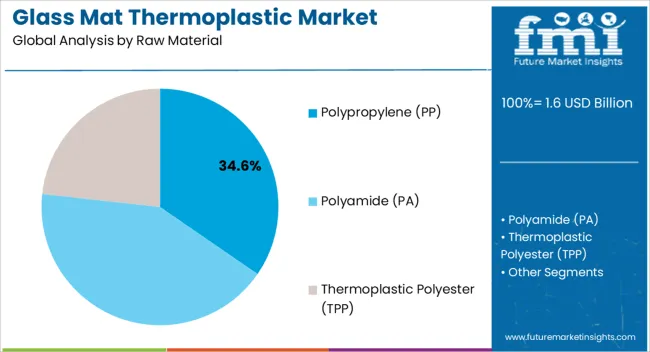
The polypropylene (PP) raw material segment is projected to hold 34.6% of the market revenue in 2025, establishing it as the leading raw material type. Growth in this segment is being driven by PP’s lightweight properties, high chemical resistance, and compatibility with glass mat reinforcement, which enhances mechanical strength and durability. PP-based GMT materials allow for cost-effective mass production while providing flexibility in molding and forming complex geometries.
The ability to reduce vehicle weight and improve fuel efficiency has accelerated adoption in automotive and transportation applications. Continuous advancements in PP formulations and processing technologies have improved impact resistance, thermal stability, and recyclability, making it a preferred choice among manufacturers.
Additionally, PP enables integration with various thermoplastic additives to tailor material performance for specific applications As demand for lightweight and high-performance composites rises, the polypropylene segment is expected to maintain its leading position, driven by operational efficiency, sustainability, and compatibility with evolving manufacturing requirements.
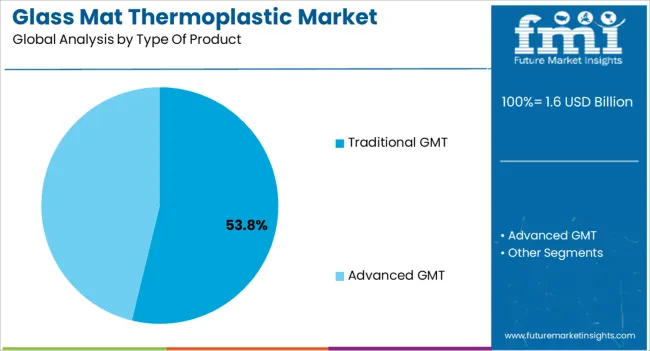
The traditional GMT type of product segment is anticipated to account for 53.8% of the market revenue in 2025, making it the leading product type. Growth is driven by the widespread adoption of established GMT manufacturing processes, which allow high-volume production with consistent quality. Traditional GMT offers excellent strength-to-weight ratios, dimensional stability, and impact resistance, making it suitable for automotive, transportation, and industrial components.
Its process compatibility with compression molding and other automated techniques ensures efficient production and cost optimization. Manufacturers are increasingly leveraging traditional GMT to reduce vehicle weight, improve fuel efficiency, and comply with environmental regulations.
The ability to maintain high mechanical performance while enabling design flexibility and complex geometries further strengthens adoption As automotive and transportation sectors continue to emphasize lightweight materials and regulatory compliance, the traditional GMT product type segment is expected to remain dominant, supported by operational efficiency, reliability, and proven performance in large-scale manufacturing applications.
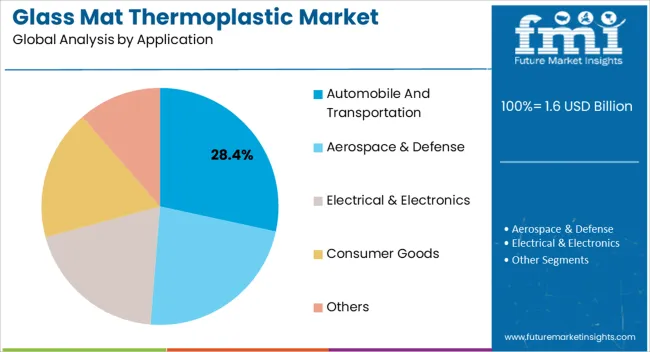
The automobile and transportation application segment is projected to hold 28.4% of the market revenue in 2025, establishing it as the leading application area. Growth is being driven by increasing demand for lightweight, high-strength materials to reduce vehicle weight and improve fuel efficiency, which is critical for meeting regulatory standards and environmental objectives. GMT materials offer excellent mechanical strength, impact resistance, and thermal stability, making them suitable for structural automotive components, interior panels, and exterior body parts.
The ability to integrate GMT into high-volume production processes such as compression molding enhances manufacturing efficiency while maintaining consistent quality. Rising adoption of electric and hybrid vehicles, which require lightweight materials to maximize battery efficiency, is further supporting this application.
Manufacturers are also leveraging GMT to meet design flexibility requirements and improve safety performance As the automotive and transportation sectors continue to focus on sustainability, fuel efficiency, and regulatory compliance, this application segment is expected to remain the primary driver of market growth.
Glass mat thermoplastic is a semi-finished product in the panel form. Glass mat thermoplastic offers better mechanical properties than injection molded reinforced thermoplastic due to its higher residual length of the glass strands. Glass mat thermoplastic is generally used as a substitute for metals such as steel and aluminum.
Glass mat thermoplastic are mostly available in the panel form but it also used in the form of 3D structural component. Glass mat thermoplastic is a light weight material with outstanding impact resistance. It has low relative density, excellent hardness and rigidity at low temperatures and durability and ease of recycling, resistance to chemicals and moisture. The demand of the glass mat thermoplastic material from the automobile and aeration industry leads to the growth of the global glass mat thermoplastic market.
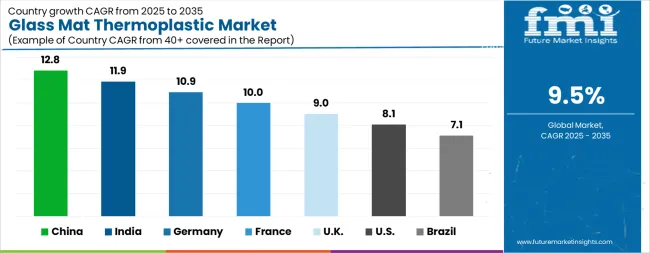
| Country | CAGR |
|---|---|
| China | 12.8% |
| India | 11.9% |
| Germany | 10.9% |
| France | 10.0% |
| UK | 9.0% |
| USA | 8.1% |
| Brazil | 7.1% |
The Glass Mat Thermoplastic Market is expected to register a CAGR of 9.5% during the forecast period, exhibiting varied country level momentum. China leads with the highest CAGR of 12.8%, followed by India at 11.9%. Developed markets such as Germany, France, and the UK continue to expand steadily, while the USA is likely to grow at consistent rates. Brazil posts the lowest CAGR at 7.1%, yet still underscores a broadly positive trajectory for the global Glass Mat Thermoplastic Market. In 2024, Germany held a dominant revenue in the Western Europe market and is expected to grow with a CAGR of 10.9%. The USA Glass Mat Thermoplastic Market is estimated to be valued at USD 619.7 million in 2025 and is anticipated to reach a valuation of USD 1.3 billion by 2035. Sales are projected to rise at a CAGR of 8.1% over the forecast period between 2025 and 2035. While Japan and South Korea markets are estimated to be valued at USD 81.9 million and USD 47.3 million respectively in 2025.
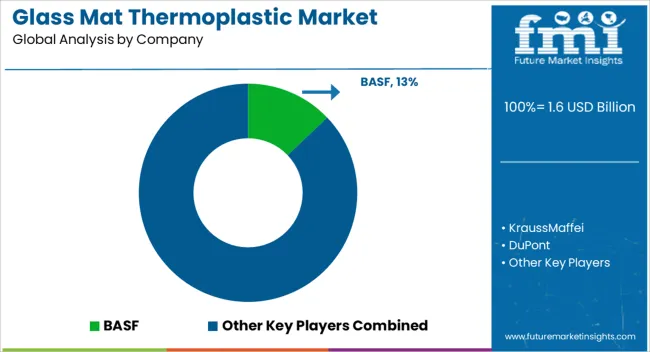
| Item | Value |
|---|---|
| Quantitative Units | USD 1.6 Billion |
| Raw Material | Polypropylene (PP), Polyamide (PA), and Thermoplastic Polyester (TPP) |
| Type Of Product | Traditional GMT and Advanced GMT |
| Application | Automobile And Transportation, Aerospace & Defense, Electrical & Electronics, Consumer Goods, and Others |
| Regions Covered | North America, Europe, Asia-Pacific, Latin America, Middle East & Africa |
| Country Covered | United States, Canada, Germany, France, United Kingdom, China, Japan, India, Brazil, South Africa |
| Key Companies Profiled | BASF, KraussMaffei, DuPont, Nextel, Owens Corning, Solvay, Mitsui Chemicals, Hexion, Toray Industries, Hyosung, Hexcel, SABIC, SGL Carbon, and Teijin |
The global glass mat thermoplastic market is estimated to be valued at USD 1.6 billion in 2025.
The market size for the glass mat thermoplastic market is projected to reach USD 4.1 billion by 2035.
The glass mat thermoplastic market is expected to grow at a 9.5% CAGR between 2025 and 2035.
The key product types in glass mat thermoplastic market are polypropylene (pp), polyamide (pa) and thermoplastic polyester (tpp).
In terms of type of product, traditional gmt segment to command 53.8% share in the glass mat thermoplastic market in 2025.






Our Research Products

The "Full Research Suite" delivers actionable market intel, deep dives on markets or technologies, so clients act faster, cut risk, and unlock growth.

The Leaderboard benchmarks and ranks top vendors, classifying them as Established Leaders, Leading Challengers, or Disruptors & Challengers.

Locates where complements amplify value and substitutes erode it, forecasting net impact by horizon

We deliver granular, decision-grade intel: market sizing, 5-year forecasts, pricing, adoption, usage, revenue, and operational KPIs—plus competitor tracking, regulation, and value chains—across 60 countries broadly.

Spot the shifts before they hit your P&L. We track inflection points, adoption curves, pricing moves, and ecosystem plays to show where demand is heading, why it is changing, and what to do next across high-growth markets and disruptive tech

Real-time reads of user behavior. We track shifting priorities, perceptions of today’s and next-gen services, and provider experience, then pace how fast tech moves from trial to adoption, blending buyer, consumer, and channel inputs with social signals (#WhySwitch, #UX).

Partner with our analyst team to build a custom report designed around your business priorities. From analysing market trends to assessing competitors or crafting bespoke datasets, we tailor insights to your needs.
Supplier Intelligence
Discovery & Profiling
Capacity & Footprint
Performance & Risk
Compliance & Governance
Commercial Readiness
Who Supplies Whom
Scorecards & Shortlists
Playbooks & Docs
Category Intelligence
Definition & Scope
Demand & Use Cases
Cost Drivers
Market Structure
Supply Chain Map
Trade & Policy
Operating Norms
Deliverables
Buyer Intelligence
Account Basics
Spend & Scope
Procurement Model
Vendor Requirements
Terms & Policies
Entry Strategy
Pain Points & Triggers
Outputs
Pricing Analysis
Benchmarks
Trends
Should-Cost
Indexation
Landed Cost
Commercial Terms
Deliverables
Brand Analysis
Positioning & Value Prop
Share & Presence
Customer Evidence
Go-to-Market
Digital & Reputation
Compliance & Trust
KPIs & Gaps
Outputs
Full Research Suite comprises of:
Market outlook & trends analysis
Interviews & case studies
Strategic recommendations
Vendor profiles & capabilities analysis
5-year forecasts
8 regions and 60+ country-level data splits
Market segment data splits
12 months of continuous data updates
DELIVERED AS:
PDF EXCEL ONLINE
Glass Rolling Forming Machine Market Size and Share Forecast Outlook 2025 to 2035
Glass Liquor Bottle Market Size and Share Forecast Outlook 2025 to 2035
Glass Bottles Market Forecast and Outlook 2025 to 2035
Glass Laser Engraving Machine Market Size and Share Forecast Outlook 2025 to 2035
Glass Restoration Kit Market Size and Share Forecast Outlook 2025 to 2035
Glass Bottle and Container Market Forecast and Outlook 2025 to 2035
Glass Additive Market Forecast and Outlook 2025 to 2035
Glass Reactor Market Size and Share Forecast Outlook 2025 to 2035
Glass Cosmetic Bottle Market Size and Share Forecast Outlook 2025 to 2035
Glass & Metal Cleaner Market Size and Share Forecast Outlook 2025 to 2035
Glass Product Market Size and Share Forecast Outlook 2025 to 2035
Glassine Paper Market Size and Share Forecast Outlook 2025 to 2035
Glass Container Market Size and Share Forecast Outlook 2025 to 2035
Glass Fibre Yarn Market Size and Share Forecast Outlook 2025 to 2035
Glass Cloth Electrical Insulation Tape Market Size and Share Forecast Outlook 2025 to 2035
Glass Bonding Adhesive Market Size and Share Forecast Outlook 2025 to 2035
Glass Table Bacteria Tank Market Size and Share Forecast Outlook 2025 to 2035
Glassine Paper Industry Analysis in Western Europe Size and Share Forecast Outlook 2025 to 2035
Glassine Paper Industry Analysis in Korea Size and Share Forecast Outlook 2025 to 2035
Glassine Paper Industry Analysis in Japan Size and Share Forecast Outlook 2025 to 2035

Thank you!
You will receive an email from our Business Development Manager. Please be sure to check your SPAM/JUNK folder too.
Chat With
MaRIA